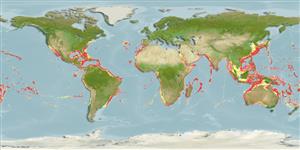Common names from other countries
>
Scombriformes (Mackerels) >
Gempylidae (Snake mackerels)
Etymology: Diplospinus: Greek, diploos = twice + Latin, spina = spine, thorn (Ref. 45335).
Environment: milieu / climate zone / depth range / distribution range
Ecologia
marinhas bentopelágico; intervalo de profundidade 50 - 1000 m (Ref. 9784). Deep-water; 42°N - 38°S, 180°W - 180°E
Atlantic, Indian and Pacific: in central water masses. Rather rare, but relatively abundant in the northwest and southeast Atlantic and southeast Pacific Ref. 6181).
Length at first maturity / Tamanho / Peso / Idade
Maturity: Lm ?, range 16 - ? cm
Max length : 33.0 cm SL macho/indeterminado; (Ref. 9784); common length : 20.0 cm SL macho/indeterminado; (Ref. 6181)
Espinhos dorsais (total): 30 - 36; Raios dorsais moles (total): 35-44; Espinhos anais 2; Raios anais moles: 28 - 35; Vértebras: 57 - 64. Body is extremely elongate and compressed. Lower jaw extends anterior to upper jaw with a small conical dermal process. Upper jaw with 3 immovable and 3 or 4 movable fang-like teeth anteriorly. Lateral line situated closer to the ventral profile than the dorsal profile posteriorly. Color is silvery with narrow dark dotted lines along the body; the gill membranes are jet-black.
Oceanic, migrating upward at night to 100 to 200 m (Ref. 6181). Probably forming schools during daytime (Ref. 6181). Feed on crustaceans and small fish (Ref. 6181). Females mature at about 16 cm (Ref. 36731). Eggs and larvae are pelagic (Ref. 6766).
Nakamura, I. and N.V. Parin, 1993. FAO Species Catalogue. Vol. 15. Snake mackerels and cutlassfishes of the world (families Gempylidae and Trichiuridae). An annotated and illustrated catalogue of the snake mackerels, snoeks, escolars, gemfishes, sackfishes, domine, oilfish, cutlassfishes,. scabbardfishes, hairtails, and frostfishes known to date. FAO Fish. Synop. 125(15):136 p. (Ref. 6181)
Categoria na Lista Vermelha da IUCN (Ref. 130435)
CITES (Ref. 128078)
Not Evaluated
Ameaça para o homem
Harmless
Utilização humana
Pescarias: pescarias de subsistência
Mais informação
ReferênciasAquaculturaPerfil para aquaculturaEstirpesGenéticaElectrophoresesHereditariedadeDoençasProcessamentoMass conversion
Ferramentas
Relatórios especiais
Descarregue XML
Fontes da internet
Estimates based on models
Preferred temperature (Ref.
115969): 8.7 - 19.2, mean 13.1 (based on 808 cells).
Phylogenetic diversity index (Ref.
82804): PD
50 = 1.0000 [Uniqueness, from 0.5 = low to 2.0 = high].
Bayesian length-weight: a=0.00363 (0.00163 - 0.00807), b=3.10 (2.91 - 3.29), in cm Total Length, based on LWR estimates for this (Sub)family-body shape (Ref.
93245).
Nível Trófico (Ref.
69278): 3.5 ±0.52 se; based on food items.
Resiliência (Ref.
120179): Médio, tempo mínimo de duplicação da população 1,4 - 4,4 anos (Fec=1,200).
Fishing Vulnerability (Ref.
59153): Low to moderate vulnerability (30 of 100).
